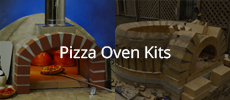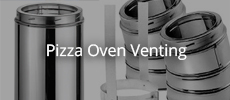Originally posted by carioca
View Post
X
-
Re: No Form Brick Oven
The bricks are 2.5"x4.5"x9.5". The only don't line up when you look straight in, but as you go around on the sides some end up lining up because the diameter decreases but the firebrick dimensions are the same. I thought I could cut bricks where they were going to line up but I was lazy to jump off and on the block stand. Its a killer on the knees.
-
Re: No Form Brick Oven
I used a cardboard cutout with the curve I wanted. I made angled brick wedges on top of the first row otherwise I would have had two to two and a half inches of mortar on the outside on that row of row of bricks. In regards to the block stand, it is personal preference. I mortared the joints and filled all the cavities with concrete.Originally posted by stevest View PostCamarina,
I'm considering to build my first brick oven this Spring (I live in the New York City area and it is now too cold to do concrete and brick work). I was impressed with your detailed photos. Two questions:
(1) The first row of bricks stand up straight, but from the second row up the bricks are all angled upwards (from the back of the brick) to make the curvature of the dome. But how do you know by how much to angle the bricks? Too shallow and the dome might look like a tall cone. Too steep and the dome will be rather flat.
(2) When building the cinderblock foundation, the web site says not to motar the blocks, just stack them, and fill every other hole with concrete and a rebar. But then when you pour the sub base of the oven, how do you keep the concrete from falling into the other holes that were not previously filled with concrete?
Thanks,
Steve
Leave a comment:
-
Re: No Form Brick Oven
(1) What ever you decide as the form of your oven curve, you make a series of forms, out of plywood, or rigid foam, or a pile of sand, or just about anything, and use these as a guide to laying your bricks. The person who started this thread didn't use any forms, but that is the exception to the rule, and depends upon using a good refractory mortar rather than the inexpensive fireclay/sand/portland mix that a lot of people have used for the pompeii.
(2) The easiest way of not filling empty block cores is to jam empty concrete sacks into the hole.
Leave a comment:
-
Re: No Form Brick Oven
Camarina,
I'm considering to build my first brick oven this Spring (I live in the New York City area and it is now too cold to do concrete and brick work). I was impressed with your detailed photos. Two questions:
(1) The first row of bricks stand up straight, but from the second row up the bricks are all angled upwards (from the back of the brick) to make the curvature of the dome. But how do you know by how much to angle the bricks? Too shallow and the dome might look like a tall cone. Too steep and the dome will be rather flat.
(2) When building the cinderblock foundation, the web site says not to motar the blocks, just stack them, and fill every other hole with concrete and a rebar. But then when you pour the sub base of the oven, how do you keep the concrete from falling into the other holes that were not previously filled with concrete?
Thanks,
Steve
Leave a comment:
-
Re: Catenary Arches
Here's the money quote from the wikipedia article cited above:
What is a "low dome" oven but a low cylindrical kiln, that needs re-inforcement to keep from bulging outward. Pizza ovens are not subject to the intensity of thermal change as pottery kilns, but the same forces (and thermal cycles are still in play.Originally posted by wikipediaA kiln, a kind of oven for firing pottery, may be made from firebricks with a body in the shape of a catenary arch, usually nearly as wide as it is high, with the ends closed off with a permanent wall in the back and a temporary wall in the front. The bricks (mortared with fireclay) are stacked upon a temporary form in the shape of an inverted catenary, which is removed upon completion. The form is designed with a simple length of light chain, whose shape is traced onto an end panel of the form, which is inverted for assembly. A particular advantage of this shape is that it does not tend to dismantle itself over repeated heating and cooling cycles ? most other forms such as the vertical cylinder must be held together with steel bands.
Leave a comment:
-
Re: Catenary Arches
I found a link somewhere to an India site that explains the catenary principle and its application to dome design very well - can't put my hands on it just now but Google should suffice :-)Originally posted by Xabia Jim View PostCatenary....caught a memory bank somewhere..... Gaudi, the Spanish Architect used the Catenary arches in a lot of his work in Spain. I remember seeing models of his strings hanging upside down in the Sagrada Familia in Barcelona.
This link might be of interest:
Catenary - Wikipedia, the free encyclopedia
I was sufficiently impressed to take an old chain (catena), pin it to a piece of hardboard and let it hang between the mid-wall points of my planned 1 m internal diameter oven: it yielded a curve that is somewhat steeper than I'd have 'intuitet'... But the Indian site explains very well the force lines through such a dome, and why your construction should be midway along the catenary lines...
Ciao,
Carioca
Leave a comment:
-
Re: No Form Brick Oven
Inspiring job, mate! I particularly liked the arch portion. Two questions if I may: what size are your firebricks? And I notice you changed tack a bit after the first few courses to ensure the perpends don't line up - I've been thinking about this and believe I'll cut my bricks at the arch junction so as to have (half) bricks and avoid joints that line up from course to course... but I believe this shouldn't really matter in a domed oven!
Cheers,
Carioca
Leave a comment:
-
Re: No Form Brick Oven
wet enough not to push the other brick next to it out of alignment, but the other thing is if the other one next to it is out of alignment a bit just nudge it back. The key is to hold it just for a while. by a while a mean it could be 5 seconds or even 20 seconds depending on what ring your on and how many on a given ring you've installed. After the third or fourth on a ring is installed they set fairly well and the next one you put on will not push the other out of place. Also I found it easier to put the mortar on the bottom and the side attaching to the other brick so the start setting together forming a stronger structure. and more surface area of that brick is sticking to something. At the ninth ring I also cut the bricks smaller so less weight to hold up.
Leave a comment:
-
Re: No Form Brick Oven
Camarina,
What consistency was the mixture and what prevented the bricks from slipping.
I'm even more impressed!
Amature mason here.....
Leave a comment:
-
Re: No Form Brick Oven
Thank you. I am a General Contractor. But my specialty is wood or so I thought.
Leave a comment:
-
Re: No Form Brick Oven
Carmarina,
I'm a professional mason, and I have to say you've done a job any pro would be proud to call his own.
Well done.
Jim
Leave a comment:
-
Re: No Form Brick Oven
i don't know how to reduce size or quality of pics to post them that is why i put them on Yahoo.
Leave a comment:
-
Re: No Form Brick Oven
Jengineer posted a great link about the catenary arch a while back.. Hey mate, any chance you would post some of your photos here on the fornobravo site? The yahoo site took a while to load for me.. My Mac is very fast and I have broadband..
Leave a comment:
-
Catenary Arches
Catenary....caught a memory bank somewhere..... Gaudi, the Spanish Architect used the Catenary arches in a lot of his work in Spain. I remember seeing models of his strings hanging upside down in the Sagrada Familia in Barcelona.
This link might be of interest:
Catenary - Wikipedia, the free encyclopedia
Leave a comment:





Leave a comment: